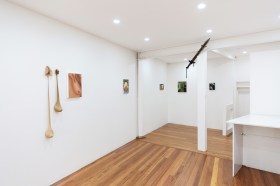Investment in arts and culture has many stated purposes at all three levels of government: to support diplomacy; to create jobs, economic growth and export products; to help sustain regional communities; to compete more effectively for domestic and international tourism; to address intractable social and policy problems; to improve educational outcomes— even some which are cultural, like telling our stories here and on the world stage.
These arguments are seen to be necessary to ‘sell’ arts and cultural investment to a Cabinet, or to ensure that that investment is welcomed by the broader community.
In state planning documents, arts and culture are accorded a priority in their own right only in Tasmania Together, which contains a dedicated goal statement, strategies, targets and measures. In the Festival State, the South Australian State Plan acknowledges arts and culture under the rubric of ‘a vibrant city’—as a tool for making Adelaide an attractive place to live and visit. In the Victorian NSW and Queensland statements, arts and culture are not mentioned as first or second order issues: the focus is on economic growth; improving government services; infrastructure; accountability; and fostering local communities—which may or may not have a passing reference to liveability and vibrancy. These statements determine budget priorities and where savings targets will or will not fall; they inform a whole lot of less obvious but often critical matters—like the status or ranking of portfolios, the structure of planning and reporting documents, Ministerial appointments, and structure and levels of staffing.
Without an explicit recognition of arts and culture as a priority of government, arts agencies find that they have little choice but to align their language, develop their arguments, and adopt and report on their outcomes in ways that fit the prevailing framework. This can have bizarre outcomes. In one year, Arts Queensland was represented in the Strategic Plan of its host department exclusively by targets related to volunteering and growing income and employment opportunities for Indigenous people. In the long run, this only serves to reinforce the view of arts and culture as incidental to the main business of government, rather than part of that business in their own right.
Scale is also a big challenge for arts agencies: an additional million dollars annually for an arts program will change the impact of that program forever: for state infrastructure or human services, a million dollars is a rounding error. Yet the effort to justify, analyse, brief and report on the money is very similar. In the words of a senior Treasury official: ‘I’m dealing with billion dollar requests from other portfolios—it’s hardly worth my time to brief on a million for an arts project.’ In effect, it’s easier just to say ‘No’ and avoid the work. This can also mean that consideration of arts and cultural funding bids waits until the end of the budget process to get attention—in the mopping up, after the ‘real’ priorities are sorted.
Is it any wonder that arts agencies, left to second guess the terms in which they can present their case to government, become cautious about bidding for funds and lose confidence in their case? Fearing that even their best proposals will fall foul of this approach, and reluctant to expose their Minister to a process which is doomed at the outset, they begin to self-censor.
Ministers themselves add another dimension. Ministers coming to portfolios like education and health bring personal experience and opinion to the task, and a clear perception of these areas as publicly provided services which touch the lives of their voters directly. Ministers coming to an arts portfolio often do so with little knowledge of the arts and cultural sector, its traditions, funding history, and policy challenges. They will have a conceptual framework of the traditional art forms (orchestra, ballet, opera, musicals) and the major institutions (galleries and museums) but little of the rest. This can lead them to question their Government’s role and to be cautious about promoting or defending arts and cultural agendas. This may be reinforced by advisors who think there is nothing to be gained by being a strong performer in the arts, and indeed, much to be lost in the electorate if the Minister is seen to be too attached to his arts and cultural responsibilities. It is a curious feature of Australian politics, that at a time when all the data show that an extraordinary proportion of Australians are engaged with arts and culture, Ministers and advisors still persist in seeing the arts as risky and electorally unrewarding territory.
One of biggest challenges for arts agencies is also the biggest paradox. Politicians may be wary of being accused of philistinism, but can be reluctant to recognise the expertise which underpins the arts and art-making. Nowhere is this more apparent than in the sphere of public art, where Ministers will express a view about the quality of an art work or the cost of its acquisition, without respect for its provenance, the standing of the artist, the complexity of the fabrication process, or the reasons for its choice. They choose to align themselves with the least informed of public opinion. The inconvenient truth is that some see artists as indulging in their hobby. The lifetime of professional study, research and development, refined by peer review and fierce public critique, which informs a successful artist, is not understood, or just not rated. Contrast this with the respect shown to scientific researchers or engineers. For me, this is a just one more reason for including the arts in the national curriculum.
Of course, on those occasions when the Arts Minister is a leading figure in government and sees a positive value for the arts, a golden age can ensue, revealing the importance of political leadership in keeping arts and culture on the agenda. The point is, however, that arts and culture are especially dependent on this alignment of stars, because our system of government at all levels has yet to reach a consensus on why public money should support arts and culture.
Without a fundamental agreement on purpose, cultural policy is destined to re-work the same debates, and to be captured by the language of other policy agendas. The design of structures and support systems which are ‘fit for purpose’ will continue to be elusive.
So in this context, is it any wonder that the task of developing a National Cultural Policy has proved to be such a challenge?
This article is an extract from Platform Papers 34, It’s Culture, Stupid! Reflections of an arts bureaucrat, published 1 February 2013 by Currency House. Platform Papers is a quarterly series of single essays raising debate on contemporary issues affecting the health of the performing arts.






